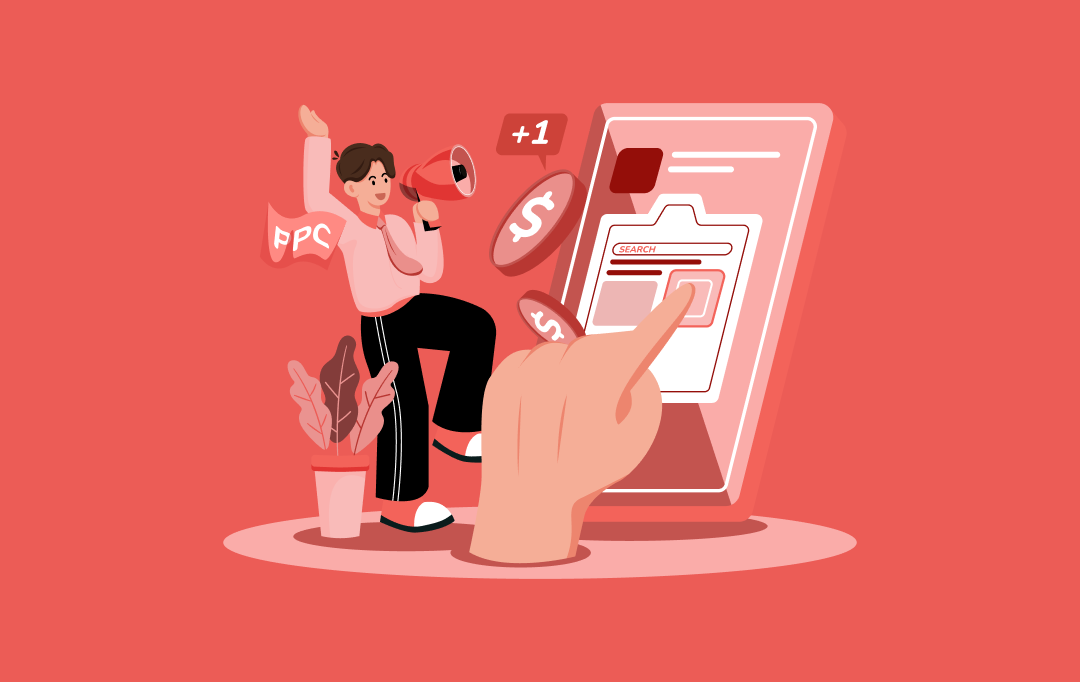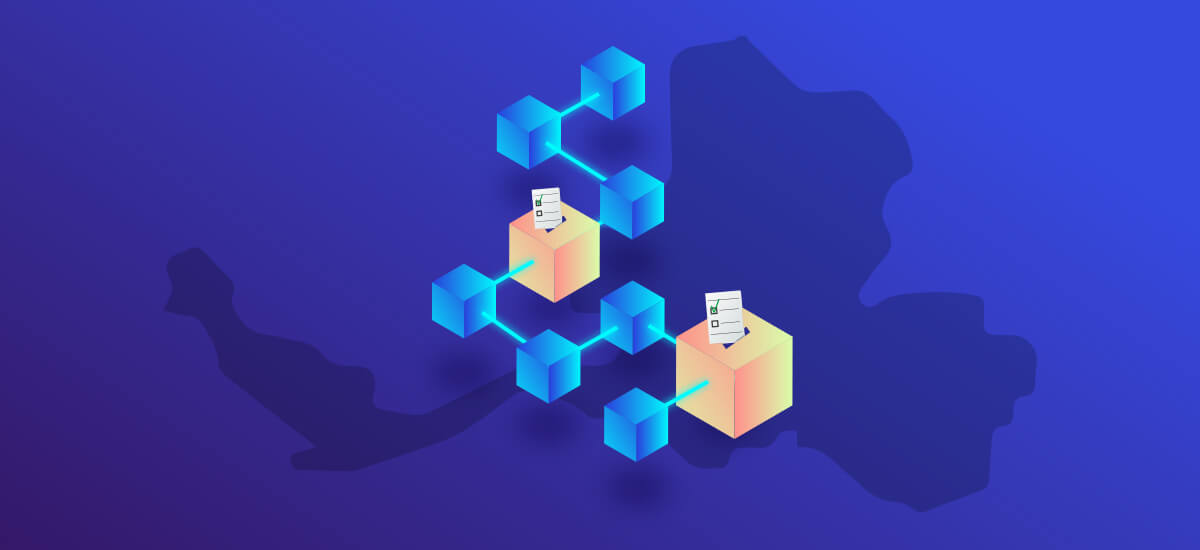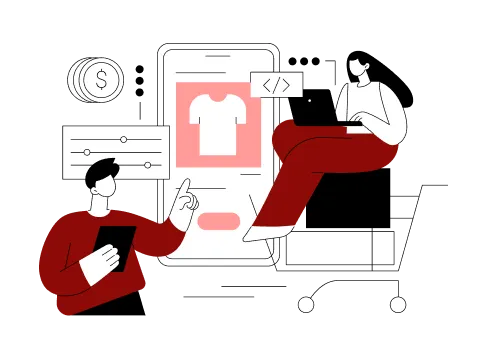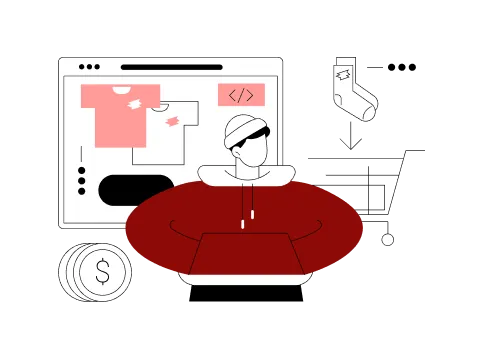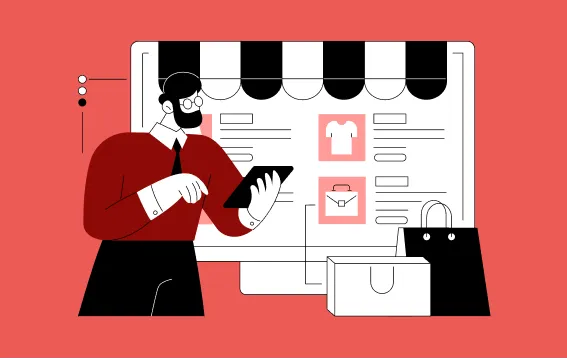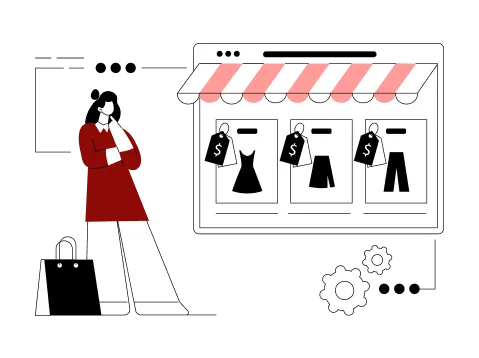- The Australian e-Commerce Landscape in 2026
- Top 10 High-Return eCommerce Business Ideas in Australia in 2026
- 1. Niche Online Stores
- 2. Subscription Boxes
- 3. Personalized Products
- 4. Health and Wellness Products
- 5. Online Education and Digital Learning Platforms
- 6. Sustainable Fashion
- 7. Pet Products and Services
- 8. Digital Art and NFTs
- 9. Digital Products
- 10. Online Grocery Delivery Services
- Top 10 AI & Tech-Driven eCommerce Business Ideas for Australia 2026
- 1. AI-Powered Personalized Shopping
- 2. Predictive Logistics & Smart Warehousing
- 3. Voice-Activated Shopping
- 4. Augmented Reality Shopping
- 5. AI-Powered Marketplaces for Local Artisans
- 6. AI Chatbots for Sales and Support
- 7. Smart Wearables and Fitness Tech
- 8. Virtual Try-Ons for Eyewear and Cosmetics
- 9. IoT-Connected Smart Home Devices
- 10. Automated Clothing Customization
- How to Start an eCommerce Business in Australia in 2026
- Common Challenges with Aussie eCommerce Startups
- Government Grants for eCommerce Startup Ideas in Australia
- How Appinventiv Supports Profitable Business Ideas for the Ecommerce Industry
- FAQs
Key takeaways:
- Australia’s eCommerce surge isn’t just about numbers, it’s about mindset. Consumers expect personalization, speed, and sustainability as standard, not extras.
- The best business ideas address a genuine problem. From pet care to sustainable fashion, the niches winning in 2026 will be the ones that understand specific customer pain points.
- Technology is the quiet differentiator. Brands that use AI, AR, or automation to make shopping easier and smarter will lead the next wave of growth.
- Compliance, trust, and transparency now decide who lasts. Businesses that respect data privacy, deliver on promises, and communicate clearly will outlive trend chasers.
- Launching is no longer the challenge, but scaling smartly is. A strong tech foundation, clear positioning, and reliable logistics partners are what separate the startups that thrive from those that fade.
Australia’s eCommerce market is expanding fast, making this the perfect time for entrepreneurs to step in and launch their businesses. If you’ve been considering an eCommerce startup idea in Australia, 2026 might be the year to leap.
As per Mordor Intelligence, the Australian e-commerce market size stands at USD 43.61 billion in 2025 and is projected to expand to USD 108.16 billion by 2030. Yet the bigger story is that more than 80% of Australians now shop online regularly.
Today’s shoppers care about sustainability. They want products tailored to their needs. They’re looking for brands that actually align with their values, especially around health and wellness. These shifting preferences are creating real opportunities in the market openings for businesses that understand what Australian consumers actually want right now, not what worked three years ago.
In this blog, we’ll go through 10+ eCommerce business ideas in Australia that are set to succeed in 2026. Each one’s backed by current market data, genuine consumer demand, and trends we’re seeing play out in real time. Whether you’re thinking about launching a specialized niche store, want to use technology in smarter ways, or have spotted a gap nobody’s filling yet, there’s likely something here worth your attention.
With the market projected to hit USD 108.16 billion by 2030, now’s the time to act. Partner with us to bring your ecommerce business idea in Australia to life.
The Australian e-Commerce Landscape in 2026
As ecommerce business ideas in Australia continue to evolve, understanding the Australian market dynamics is crucial. As stated above, the Australian e-commerce market size is projected to expand to USD 108.16 billion by 2030, as per Mordor Intelligence.
Such projections matter, but the more interesting story is why this growth is happening.
- The personalization expectation has become standard operating procedure. Personalization is now a baseline expectation in Australia. A recent report reveals that nearly 70% of Australian consumers expect personalized shopping experiences. This isn’t about having a responsive website anymore; shoppers now expect platforms to use technologies like generative AI, which can recognize them, remember their preferences, and surface relevant products without forcing them to search.
- Local competition is no longer your primary concern. An Australian retailer isn’t just competing with the business down the street; they’re competing with US and UK retailers offering comparable products at different price points, often with surprisingly quick international shipping. This forces local businesses to compete on factors beyond just having a physical presence: value proposition, customer service, delivery speed, and product curation all matter more now.
- AI implementation has moved from experimental to operational. The technology finally delivers on earlier promises. Retailers are using machine learning for product recommendations that actually make sense, inventory forecasting that reduces waste, and customer service automation that doesn’t frustrate people.
- Environmental credentials are now a purchasing factor, not a brand differentiator. Sustainability is a purchase driver. Recent Australian research indicates ~76% of consumers factor sustainability into purchase decisions. Customers examine packaging materials, research supply chains, and call out greenwashing when they spot it. This creates both risk and opportunity. Businesses with genuine sustainability practices can build significant brand loyalty.
- Mobile commerce has become the primary channel for many consumers. 45% of e-commerce volume in Australia comes from mobile devices (vs. 55% desktop). Coupled with the rapid adoption of Buy Now, Pay Later services, this means businesses need mobile experiences that handle the full purchasing journey seamlessly, not just browsing that forces users to complete checkout on a desktop.
Also Read: Top 10 eCommerce app features for startups and enterprises
Top 10 High-Return eCommerce Business Ideas in Australia in 2026
The Australian online shopping market is becoming more sophisticated, with faster payments, sharper delivery networks, and a growing willingness to buy online. If you’ve been contemplating starting an ecommerce business in Australia, here are 10 ideas that balance high potential returns with long-term relevance.
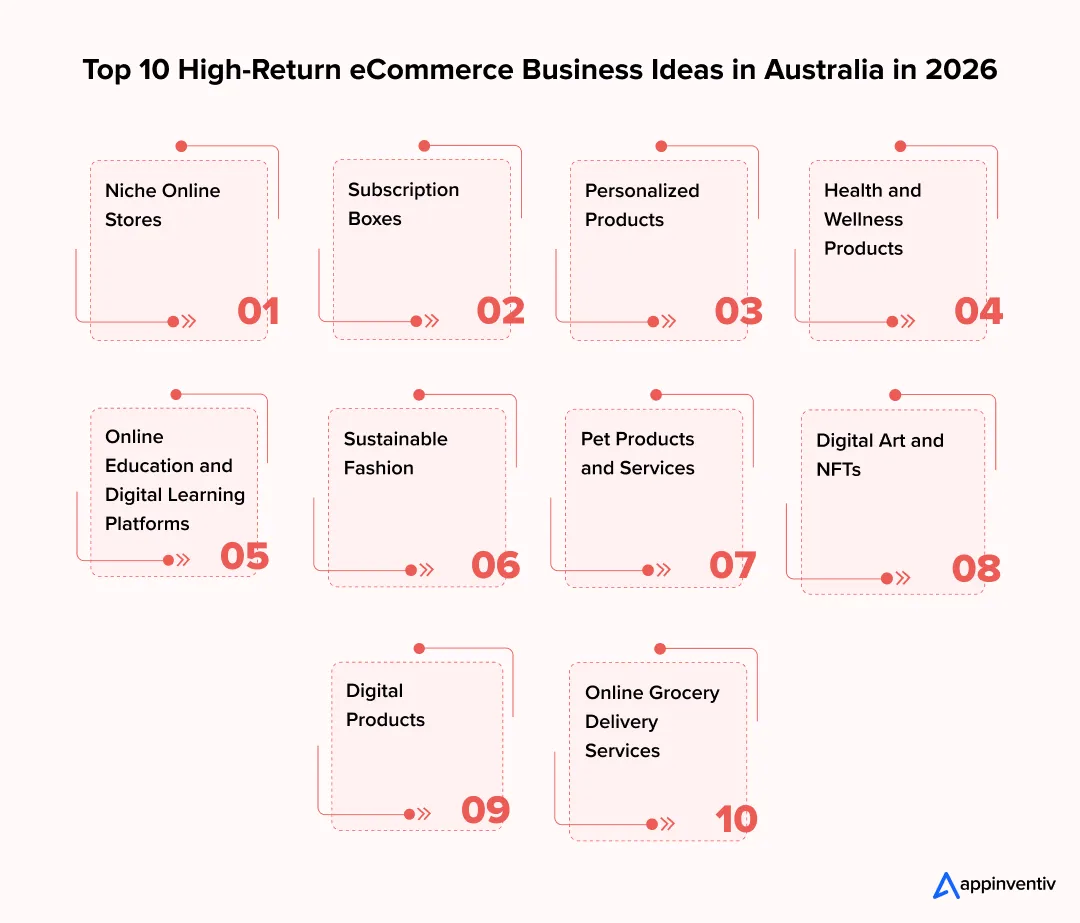
1. Niche Online Stores
Trying to sell to everyone usually means you end up selling to no one. Niche stores work because they solve specific problems for specific people.
Benefit: Targeting a niche allows you to refine your marketing efforts, reduce customer acquisition costs, and build a dedicated community. This is a highly profitable approach that aligns with ecommerce business ideas for launching in Australia.
Example- The Iconic, one of Australia’s leading fashion e-commerce platforms, carved a unique niche by focusing solely on fashion and lifestyle products. By narrowing its focus to a specific market segment, it has been able to offer a curated selection that appeals to a dedicated customer base, avoiding the overwhelming clutter of trying to sell everything to everyone.
2. Subscription Boxes
Predictable revenue changes how you run a business. When you know what’s coming in next month, you can plan inventory better, negotiate with suppliers more effectively, and actually focus on improving your product instead of constantly chasing new customers.
Subscription models also shift the relationship dynamic. You’re not making a one-time sale; you’re maintaining an ongoing connection.
Benefit: Recurring revenue provides business stability, and customers love the personalized experience, leading to higher lifetime value. With ecommerce business ideas in Melbourne and other major cities growing, this market offers long-term potential.
Daily Blooms offers a flower subscription service that delivers fresh, seasonal bouquets to customers’ doors in major Australian cities. With flexible delivery options, including fortnightly or monthly plans, Daily Blooms caters to customers, enhancing customer satisfaction and fostering business growth.
3. Personalized Products
Mass production made things cheaper. Personalization makes them valuable again.
Australians are increasingly willing to pay premiums for products that they feel are specifically made for them. It’s not just their name printed on something; it’s actual customization that reflects their preferences, needs, or style.
Benefit: From a business perspective, personalization justifies higher margins. And customers who’ve invested time in customizing something are far less likely to return it or switch to a competitor.
Example: StyleRocks is an Australian online company that offers custom-made jewelry, allowing customers to design their own bespoke items, including necklaces, rings, cufflinks, earrings, and bracelets. The brand will enable customers to print their desired ring design in 3D before purchase, providing a unique and personalized shopping experience.
4. Health and Wellness Products
Australia’s health and wellness market isn’t slowing down. If anything, it’s accelerating. People are spending serious money on products that support their health goals- supplements, fitness equipment, wellness tech, mental health tools.
Repeat purchases are common in this sector, offering long-term profitability. If you target the right audience, profitable business ideas for the eCommerce industry, such as health supplements or fitness accessories, are bound to grow.
Example: Swisse is a leading Australian vitamin and supplement brand known for its science-backed formulations. The company has expanded its product range to include skincare and sports nutrition, solidifying its position in the wellness industry.
5. Online Education and Digital Learning Platforms
The shift to online learning is permanent, opening the door for ecommerce startup ideas in Australia that focus on education. Offering digital courses, certifications, or workshops can cater to a broad audience seeking continuous learning.
Digital education has exceptional unit economics once you’ve created the content. Your initial development costs are significant, but after that? You can sell the same course to one person or ten thousand with minimal additional expense. No inventory, no shipping, no physical constraints.
Example: A notable Australian example is Udemy, a globally recognized online learning platform with a significant presence in the country.
6. Sustainable Fashion
Ethical fashion isn’t just a trend- it has become a purchasing criterion for a significant segment of Australian consumers. They are actively seeking brands that align with their environmental values and are willing to pay a premium for them.
The business case goes beyond feel-good marketing. Sustainable fashion brands often build stronger customer loyalty because buyers feel like they’re part of something larger. They defend the brand when others question the higher prices.
The challenge is authenticity. Consumers can spot greenwashing quickly, and the backlash is severe. But done genuinely, transparent supply chains, real environmental commitments- this market offers differentiation that’s increasingly hard to find elsewhere.
Example: A real-world, famous Australian brand excelling sustainably is Patagonia. While not originally an Australian brand, Patagonia has successfully embedded itself into the Australian market, leading the charge with ethical and environmentally-friendly practices that resonate with Australian consumers.
7. Pet Products and Services
Pet owners don’t cut back on their pets. That’s the fundamental insight driving this market’s growth. Australians are spending more on their pets than ever, and they’re less price-sensitive here than in almost any other category.
Premium pet food, wellness products, grooming services, tech solutions- all growing. The repeat purchase rate is high because pets need ongoing care. And pet owners are emotionally invested in their animals’ well-being, which means they’ll try new products that promise better health or happiness for their pets.
Example: Petbarn is one of Australia’s leading pet retail chains and a great example of capitalizing on the growing pet products and services market.
8. Digital Art and NFTs
The NFT market went through a hype cycle. Some of that hype has deflated. But beneath the speculation, a real shift is occurring in how digital creators monetize their work and how collectors view digital ownership.
For businesses, NFTs create two revenue opportunities: primary sales when you first issue them, and royalties from secondary market transactions.
If you’re in creative industries or serving tech-savvy audiences, it’s worth investing in innovative strategies. The infrastructure is maturing, and the use cases are expanding beyond just art.
Example: The Australian Open (AO) 2022 NFT Collection is a prime example of leveraging NFTs for revenue generation. The Australian Open launched its NFT collection, which included digital artwork and memorabilia, to engage fans and create new revenue streams.
9. Digital Products
Digital products have fundamentally different economics than physical goods. Create once, sell infinitely. No inventory management. No shipping logistics. No storage costs.
The margin on e-books, online courses, templates, design assets, and software tools can be 90%+ after accounting for platform fees.
The challenge with digital products isn’t production- it’s discovery and perceived value. You need strong marketing to get noticed and to clearly demonstrate value, as customers can’t touch or see what they’re buying before purchase.
Example: Canva, an Australian tech company, has revolutionized the design space with its digital product offerings. Canva’s subscription-based model for premium templates, design assets, and tools showcases the high margin potential of digital products.
10. Online Grocery Delivery Services
Online grocery shopping proved it wasn’t just a pandemic convenience- it’s a permanent shift for many Australians, particularly in urban areas. The value proposition is straightforward: time savings and convenience.
For businesses, groceries offer recurring revenue. The margins are tighter than many e-commerce categories, so efficiency matters more. Fast delivery, competitive pricing, and product quality determine whether customers stick with you or switch to a competitor. With ecommerce business ideas in Brisbane and other major cities growing, this market offers long-term potential.
Example: Coles Online and Woolworths Online are the two dominant players in Australia’s online grocery delivery market. These brands capitalized on the permanent shift to online shopping during the pandemic and have maintained strong customer loyalty.
Also Read: 15 AI Business Ideas in Australia for 2025 and Beyond
Tap into our expertise, scale smarter, and create lasting impact- let’s accelerate your growth!
Top 10 AI & Tech-Driven eCommerce Business Ideas for Australia 2026
The digital economy in Australia is shifting toward automation, artificial intelligence, and modular architectures. AI in Australia is creating opportunities for creative Australian e-commerce business concepts. These are the top ecommerce business ideas that combine market demand with cutting-edge technology. Here are the tech-driven ecommerce startup ideas in Australia worth considering:
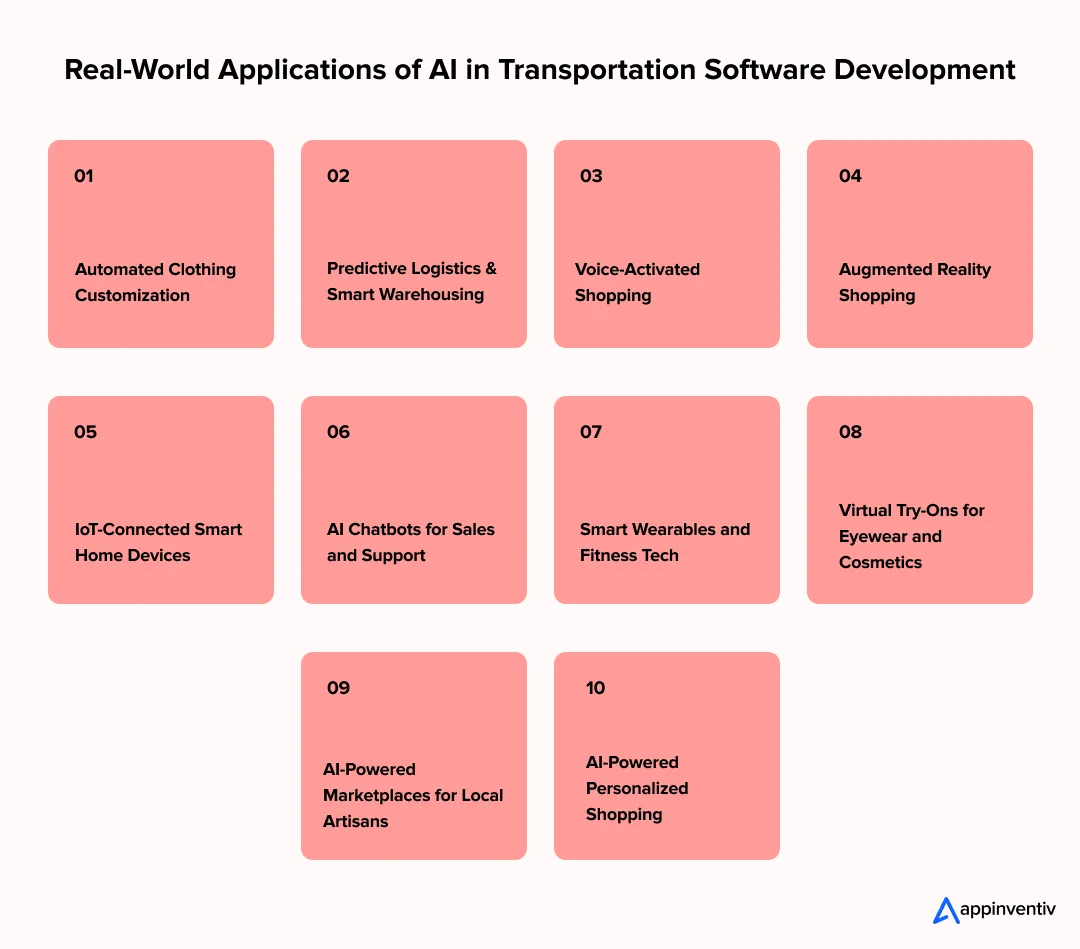
1. AI-Powered Personalized Shopping
We’ve all experienced bad product recommendations, algorithms suggesting random items because you once clicked something by accident. Done properly, AI personalization actually works now. The technology analyzes shopping patterns, browsing behavior, and purchase history to surface products customers actually want.
When a returning visitor sees items that genuinely match their style and needs, conversion rates climb significantly. The challenge is getting enough quality data and training the algorithms well.
2. Predictive Logistics & Smart Warehousing
In the fast-paced world of eCommerce, efficient supply chain management can make or break a business. Traditional logistics systems often struggle to keep up with fluctuating demand, seasonal spikes, and the complexity of managing multiple warehouses. This is where AI-powered predictive logistics and smart warehousing come into play.
Impact: Reduces operational costs and ensures faster, more reliable delivery.
3. Voice-Activated Shopping
Voice shopping hasn’t exploded the way some predicted five years ago, but it’s found its niche. Reordering household staples through Alexa or Google Home actually makes sense -nobody wants to reorder laundry detergent manually.
There is an opportunity for businesses selling consumable products to customers who regularly purchase the same items. Fashion or complex purchases through voice? Still clunky. Groceries and household goods? That’s where adoption is happening.
4. Augmented Reality Shopping
Augmented Reality (AR) is no longer just a gaming feature; it is revolutionizing the ecommerce industry. IKEA’s app, for instance, lets users see how furniture will look in their actual space. It’s not just a gimmick; it genuinely aids in decision-making. The same goes for makeup try-ons or visualizing how different paint colors appear on your walls.
The barrier to entry has significantly lowered. What once required complex, custom development is now available through accessible platforms. The result? AR-driven visualizations have led to a noticeable drop in return rates, especially in industries like furniture and home decor, where customers can confirm how products will fit before purchasing.
5. AI-Powered Marketplaces for Local Artisans
Etsy, a global eCommerce marketplace, validated the market for handmade Australian goods. Discovery remains the core challenge. Skilled artisans struggle for visibility among thousands of competing listings, while customers abandon searches after encountering irrelevant results.
AI-powered matching solves this by connecting makers with appropriate buyers- based on style preferences, quality standards, and specific requirements. A Melbourne ceramicist reaches customers seeking authentic handmade pottery rather than mass-produced alternatives. Market demand exists. Artisan supply exists. Effective infrastructure connecting them doesn’t.
6. AI Chatbots for Sales and Support
Early chatbot implementations failed customers. Current AI chatbots or conversational AI represent a substantial improvement- functional, not flawless, but operationally useful.
These systems now handle routine service inquiries: order status, return procedures, and product specifications. Your staff addresses complex issues requiring expertise and judgment.
Transparency is non-negotiable. Customers accept AI assistance when it functions effectively and human support remains accessible. Concealing automation or restricting staff access erodes trust rapidly.
7. Smart Wearables and Fitness Tech
Fitness technology has achieved mainstream adoption across Australian demographics. Smartwatches and trackers are no longer specialty products.
Hardware sales alone won’t establish a competitive advantage- market saturation is high. Build comprehensive ecosystems: establish partnerships with recognized fitness programs, deliver genuinely personalized coaching services, and integrate practical nutrition tracking functionality.
Devices generate initial transactions. Sustained value drives customer retention.
8. Virtual Try-Ons for Eyewear and Cosmetics
Shopping for glasses was miserable online before virtual try-on technology. Now, customers can see dozens of frames on their actual face in minutes. The technology works particularly well for eyewear and cosmetics because the products are meant to be seen on people. Conversion rates for these categories have jumped significantly since AR try-ons became standard. Not implementing this in 2026 would be like not having product photos in 2016.
Know how Appinventiv helped Vyrb with an AI-powered voice-assisted app for Bluetooth eyewear that led the client to achieve $1 million in funding.
9. IoT-Connected Smart Home Devices
The smart home market in Australia is moving past early adopters into mainstream adoption. People want their lights, security, heating, and appliances connected and controllable. The fragmentation is the problem- too many competing standards and apps.
An eCommerce business that simplifies smart home setup, ensures compatibility, and provides actual support (not just selling boxes) could achieve significant differentiation. Most retailers just push products. Few help customers create systems that actually work together.
10. Automated Clothing Customization
Mass customization in fashion has been “the next big thing” for years, but it has kept hitting manufacturing bottlenecks. AI-driven design tools combined with on-demand manufacturing are finally making this viable at scale. Customers design their clothes —choosing fabrics, patterns, fits, details —and automated systems handle production. The margins work better than traditional fashion retail because you’re not holding inventory or dealing with unsold stock. You produce what’s ordered.
Profitable business ideas for the ecommerce industry thrive by targeting niche markets and emerging trends. Whether it’s personalized products, subscription boxes, or eco-friendly goods, focusing on specific consumer needs can drive consistent sales and long-term profits in Australia’s growing eCommerce market.
How to Start an eCommerce Business in Australia in 2026
Launching an eCommerce business in Australia isn’t just about setting up a store and waiting for orders. The market’s competitive, the rules are shifting, and customers expect more than a checkout button. Here’s a practical way to go from idea to launch- and build something you can actually grow.
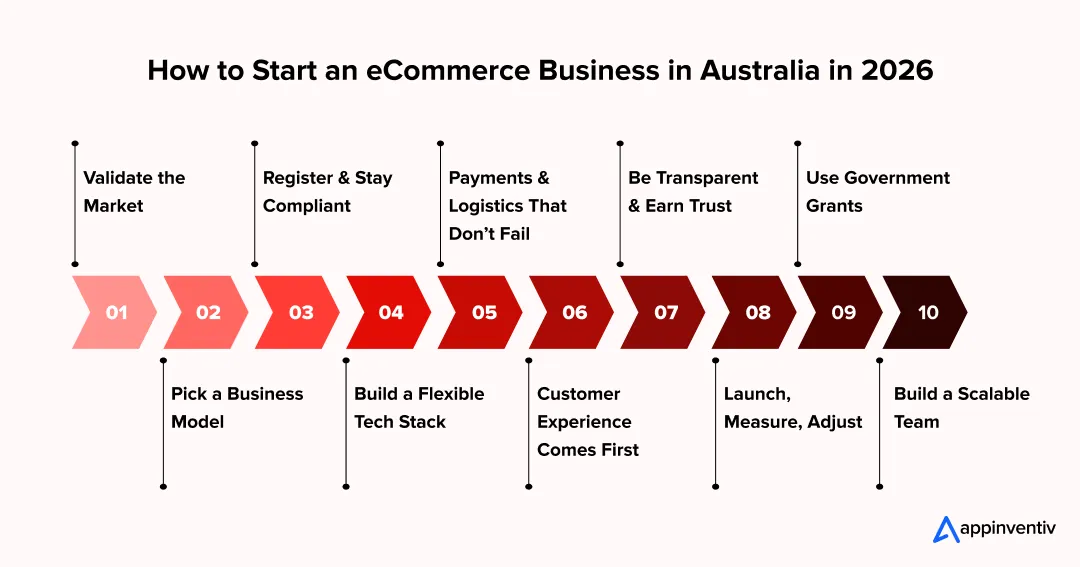
- Validate the Market
Before you spend on design or ads, find out if people will buy. Dig through Australia Post’s eCommerce reports, check IBISWorld, and play with Google Trends. See what’s selling, where it’s selling, and how shoppers behave in different cities. Sydney might be crazy about one niche; Perth might not care.
Right now, big moves are happening in sustainable products, pet tech, and health & wellness. Doing this homework early saves time, keeps you from chasing weak ideas, and shows where the real demand is.
- Pick a Business Model
How you plan to sell shapes everything – tech, shipping, even marketing spend. Some popular routes:
- Direct-to-Consumer (D2C): You own pricing, profit, and branding.
- Marketplace: Fast scale — let other sellers list, you take a cut.
- Subscription: Predictable monthly sales — think beauty boxes, meal kits, fitness plans.
- Circular Commerce: Resell or repair products; sustainability sells big right now.
Match the model to your product and how much control you want over the experience.
- Register & Stay Compliant
Handle the basics early. Get your ABN (Australian Business Number), figure out GST obligations, and protect your trademarks.
Privacy rules are also tightening. With updates to Australia’s Privacy Act (similar to GDPR), only collect what you truly need, get clear consent, and keep data secure. This isn’t just about avoiding fines —it’s how customers know you’re legit.
- Hire an eCommerce development company
Hiring an eCommerce development company is essential for building a robust, scalable online business. These experts can help navigate the complexities of creating a platform that meets regulatory compliance, ensuring the security of sensitive customer data. They also design user-friendly interfaces that enhance customer experience, while optimizing for performance and speed across devices.
As your business grows, the team ensures your platform evolves seamlessly, adapting to increasing traffic, new features, and changing market demands.
- Build a Flexible Tech Stack
Your site should be able to grow and adapt without breaking. Headless or composable platforms like Shopify Plus, BigCommerce, or MACH let you tweak and scale without tearing the whole thing down.
Add tools for AI-driven personalization, GDPR-friendly data flows, and fast payments (PayTo/NPP). Think of it like wiring the house for the future, not just plugging things in for today.
- Payments & Logistics That Don’t Fail
Most abandoned carts die at checkout. Make it easy to pay: PayPal, Apple Pay, Google Pay, BNPL options- and multi-currency if you plan to sell outside Australia.
For shipping, speed and tracking matter. Work with trusted carriers like Australia Post or Shippit. Use predictive analytics to avoid running out of stock or overstocking. Quick, reliable delivery is one of the fastest ways to win loyalty.
- Customer Experience Comes First
Getting traffic is expensive. Keeping customers isn’t, if you do it right.
- AI chatbots that actually help.
- Personalized product suggestions based on behavior.
- Fast load times- Google says just one extra second can hurt conversions by 7%.
Build for repeat buyers from day one. Loyalty programs and smooth user experiences turn one-time shoppers into regulars.
- Be Transparent & Earn Trust
People shop where they feel safe. Show what data you collect and why. Be clear on shipping times, pricing, and returns. If you’re sustainable, say how. Data Protection Impact Assessments (DPIAs) and public sustainability updates can also impress bigger partners and investors.
- Launch, Measure, Adjust
You don’t need a perfect store to start. Launch a minimum viable product (MVP)– enough to sell and learn. Track key metrics: ROAS (Return on Ad Spend), CAC (Customer Acquisition Cost), LTV (Lifetime Value). Use what you learn to refine and expand- new features, new markets, better UX.
Scaling is just small, smart steps- not a sprint.
- Use Government Grants
Australia offers numerous options for e-commerce startup funding. Investigate R&D tax incentives to finance innovation and technology development. Furthermore, Australian companies growing into foreign markets are assisted by the Export Market Development Grants (EMDG). You can reinvest in developing and improving your e-commerce platform by using these funds to help offset operating costs by up to 30%. As they provide extra funds for digital transformation, be sure to look into the state-specific funding possibilities in New South Wales, Victoria, and Queensland.
Common Challenges with Aussie eCommerce Startups
While the Australian eCommerce landscape offers incredible opportunities, it’s not without its hurdles. Many entrepreneurs face similar challenges when starting an online business, especially when pursuing profitable business ideas for the ecommerce industry. Recognizing these obstacles early on can help you navigate them more effectively. Here’s what most Aussie eCommerce startups struggle with:
- Logistics and Shipping Costs
Australia’s geography creates immediate challenges. Shipping from Perth to Sydney covers more distance than shipping from London to Moscow. This translates to expensive freight and delivery times that frustrate customers.
Solution: Find a reliable 3PL provider before you launch. Yes, it costs more upfront. But attempting to manage logistics while running your business rarely works well.
Free shipping helps if your margins support it—just verify the numbers first.
- Customer Acquisition
You can build an excellent product and still struggle if nobody knows you exist. Customer acquisition costs have climbed significantly in recent years.
Know exactly who you’re selling to. Not demographics—actual people with specific problems. Then test marketing channels systematically.
Solution: SEO takes months but compounds over time. Paid ads work faster but get expensive. Email still converts effectively. Track everything so you know what’s actually working.
- Consumer Expectations
Australian shoppers expect sites that load instantly, work perfectly on mobile, and make checkout simple. About 60% of your traffic will come from phones.
If your site isn’t mobile-optimized, you’re losing sales daily.
Solution: Start with fundamentals- fast loading, intuitive navigation, secure payment processing. Get those right before adding sophisticated features. A basic site that functions well beats a complex one that doesn’t.
- Global Competition
Your competition isn’t just local businesses anymore. International retailers often have better pricing and faster shipping. That’s the current reality.
Where you can win: specialization, don’t try to be everything to everyone, you’ll lose on price every time.
Solution: Find your niche. Serve it exceptionally well. Build relationships that large retailers can’t replicate. Compete on what differentiates you, not what makes you cheaper.
- Regulatory Compliance
Australian Privacy Principles, ACCC consumer regulations, and payment security requirements apply whether you understand them or not. Businesses face serious problems because they didn’t realize their legal obligations.
Solution: Get proper advice early. A compliance consultant costs less than the penalties that come from getting it wrong. This isn’t an area to learn through trial and error.
- Cash Flow Management
Sales don’t automatically mean available cash. Seasonal fluctuations, slow-moving inventory, delayed payments, and cash flow issues have ended more eCommerce businesses than poor products.
Solution: Use financial software from day one. Know your numbers weekly. Maintain a buffer fund for unexpected expenses.
When money gets tight, and it will at some point, know which expenses truly matter.
- Customer Retention
Acquiring a new customer costs roughly five times more than retaining an existing one. Yet most new businesses focus almost entirely on acquisition.
Your repeat customers represent the real value. They purchase more, cost less to sell to, and often bring referrals.
Solution: Good customer service, genuine loyalty programs, regular engagement – these aren’t optional extras. They’re how sustainable businesses get built.
- Technical Issues
Your payment gateway will experience problems. Your site will crash. Something will fail during your biggest promotion. Plan for it.
Test thoroughly, but accept that issues will emerge. Have reliable technical support available before launch, not after problems arise.
Solution: Don’t save $50 monthly on hosting only to lose thousands when your site fails during high traffic.
- Inventory Management
Excess stock ties up cash you need elsewhere. Insufficient stock means lost sales and disappointed customers.
Both problems can occur simultaneously when managing multiple products.
Solution: Invest in proper inventory management software. Real-time tracking prevents overselling or unexpected stockouts. Build strong supplier relationships, they can help navigate demand fluctuations better than you can alone.
Government Grants for eCommerce Startup Ideas in Australia
If you’re building an eCommerce business in Australia, there’s government funding available—though navigating it takes some effort. Here are the main programs worth knowing about:
- R&D Tax Incentive offers tax offsets when you’re developing new products or technology. This isn’t just for tech companies. If you’re innovating in any way – new logistics systems, custom software, product development – you might qualify. The paperwork’s involved, but the return can be substantial.
- Export Market Development Grants (EMDG) help small and medium businesses expand internationally. If you’re selling overseas or planning to, this covers promotional costs, market research, and trade shows. Most eCommerce businesses overlook this one, which is a mistake if you’re doing any cross-border sales.
- The Industry Growth Program provides grants ranging from AUD 50,000 ($32,000) to AUD 5 million ($3.2 million) for commercializing and scaling innovative products. The application process is competitive, but if you’ve got something genuinely new and can demonstrate market potential, it’s worth pursuing.
- Business Basics Grants Program offers up to AUD 7,500 ($4,800) for foundational business improvements- professional advice, website development, that sort of thing. It’s smaller money, but it’s also easier to access for early-stage businesses.
- State-Specific Options: Individual states run their own programs. Northern Territory’s Cyber Invest Business Program matches funding up to AUD 10,000 ($6,400) for cybersecurity improvements- something every eCommerce business needs but many underfund. South Australia’s Sustainable Business Solutions grant provides up to AUD 20,000 ($12,800) for eco-friendly waste management equipment.
Most states have something similar. Check what’s available where you’re operating.
Transform your vision into a market leader. Let’s scale your eCommerce business ideas in Australia to the next level!
How Appinventiv Supports Profitable Business Ideas for the Ecommerce Industry
Appinventiv, an ecommerce app development company in Australia, offers businesses comprehensive e-commerce solutions that are personalized to the unique needs of the market. It has been demonstrated that our approach ensures adherence, increases efficiency, and fosters growth.
We Build Infrastructure That Grows With You
Headless commerce architectures, proper product information management, PayTo-ready payments. The technical foundation that lets you scale without rebuilding everything six months later is essential.
One Australian retailer rebuilt their platform with us. Sales increased 40% within six months. Not from marketing- from a system that could finally handle what their business needed to do.
A fashion brand was launching new collections more slowly than its competitors. We implemented a modular architecture that cut their time-to-market by 30%. Same team, better tools, faster execution.
Compliance Isn’t Optional
Australian Privacy Principles and GDPR are important for international operations. We’ve watched businesses face serious problems because they treated compliance as something to worry about later.
We build privacy and security into the foundation. Automated consent management, proper DSAR handling, and region-aware analytics. A multinational retailer reduced operational costs by 30% while strengthening compliance through our systems. When you automate compliance correctly, it costs less than manual processes.
Performance Drives Revenue
P95 load times under 400ms. Autoscaling that works before your site buckles under traffic. These aren’t aspirations- they’re what we engineer into every deployment.
A B2B client’s Black Friday was a disaster. The site slowed down, customers abandoned carts, and revenue tanked. We rebuilt their infrastructure. Next Black Friday, cart abandonment dropped 50% during peak traffic.
Another client saw conversion rates jump 30% after our performance work. That’s money they were losing before because their site couldn’t handle normal traffic spikes.
Growth Requires Strategy
We use cohort analytics to understand actual customer behavior. We run AOV experiments to find what genuinely increases purchase values. We build retail media capabilities that generate revenue, not just cost money.
We specialize in turning your ecommerce business ideas in Australia into reality, helping you choose the right tech stack, features, and strategies for success. From launch to growth, we ensure your ecommerce platform is future-ready and scalable. Are you ready to take your ecommerce business to the next level? Contact Us Now!
FAQs
Q. What are the top ecommerce business ideas for startups in Australia?
A. Some of the top ecommerce business ideas in Australia include:
- Eco-friendly products like zero-waste kits and sustainable packaging.
- Health & wellness items include fitness trackers and organic food.
- Smart pet accessories like AI-enabled collars and automatic feeders.
- DIY & craft supplies focused on premium kits and tutorials.
- Educational kits with a focus on STEM and interactive learning.
Q. Are ecommerce startups profitable in Australia?
A. Yes, ecommerce startups in Australia can be highly profitable. With a growing online retail market and strong demand for niche products like eco-friendly and health items, many businesses quickly see a return on investment. The use of efficient payment methods like PayTo and real-time transactions boosts profitability by reducing fees and cart abandonment.
Q. Which are the best-suited technologies in Australia for ecommerce startups?
A. Technologies that work well for ecommerce business ideas in Australia include:
- Headless commerce platforms, such as Shopify Plus, offer flexibility and scalability.
- AI for personalized product recommendations that increase sales.
- PayTo for streamlined, real-time payments.
- Augmented reality (AR) for product visualization, especially in sectors like furniture and fashion.
- Data analytics for deeper customer insights and improving marketing.
Q. How much does it cost to start an ecommerce business in Australia?
A. The cost to launch an ecommerce business in Australia can vary from AUD 30,000 to AUD 100,000. The initial investment covers website development, payment system integrations, inventory, and marketing. For ecommerce startup ideas in Australia, costs can be lower with a focus on MVPs, while larger businesses may need a bigger budget for scaling and logistics.
Q. How to validate my ecommerce business idea in Australia?
A. To validate your ecommerce startup idea in Australia, try the following:
- Conduct market research using tools like Google Trends to spot demand.
- Competitor analysis to identify gaps and opportunities.
- Customer feedback through surveys, focus groups, or testing.
- Launch a minimum viable product (MVP) to gather real-world data and insights for future improvements.


- In just 2 mins you will get a response
- Your idea is 100% protected by our Non Disclosure Agreement.
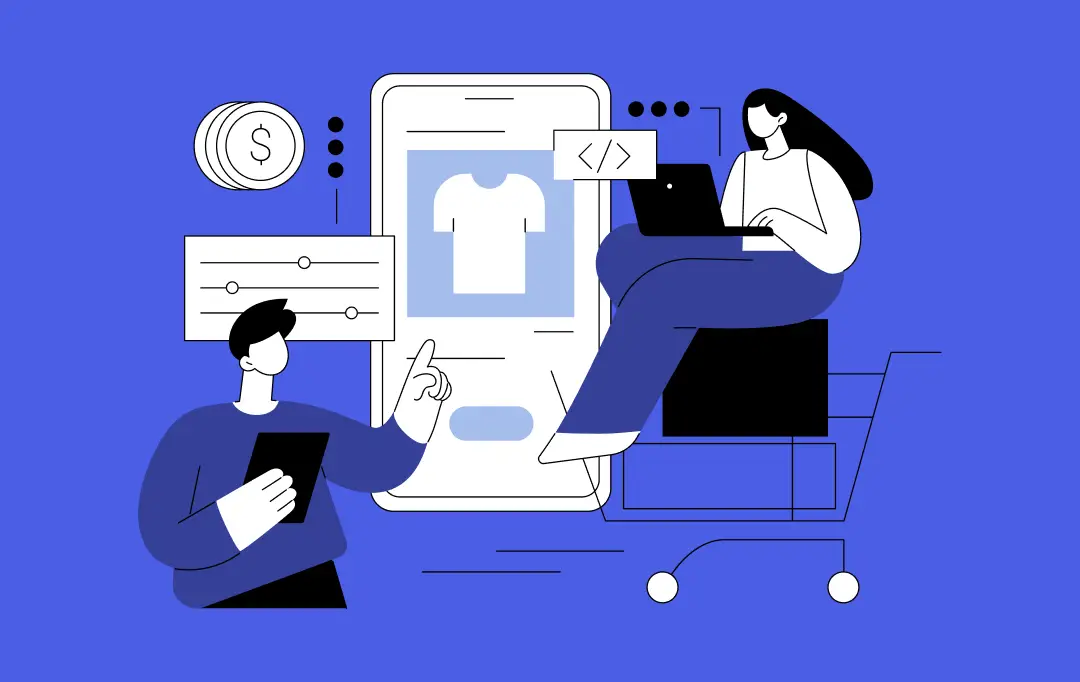
How Much Does It Cost to Develop an eCommerce Platform like The Iconic in Australia?
Key takeaways: Building an eCommerce platform like The Iconic in Australia can cost anywhere from AUD $46,500 to AUD $775,000+ depending on scale and sophistication. The real eCommerce cost drivers are backend architecture, integrations, compliance, and system reliability, not just design screens. Platforms like The Iconic succeed because they combine shopping experience, logistics, and payments…

Key takeaways: Global eCommerce fraud losses are expected to exceed $107 billion by 2029. Digital growth, Buy Now Pay Later features, and rising automation are all opening up new avenues for fraudsters to exploit. First-party abuse and refund abuse have ended up being the greatest source of pain globally, affecting nearly half of all online…

How Australian Businesses Can Build a Scalable eCommerce Logistics Strategy for Global Growth
Key takeaways: To thrive internationally, a scalable eCommerce logistics strategy for Australian businesses is indispensable. AI, blockchain, and IoT enable precise demand forecasting, streamline operations, and provide full transparency. You can overcome rising costs and limitations by focusing on decentralized warehousing, optimized inventory, and eCommerce shipping integration. Building strong ties with domestic and international logistics…












